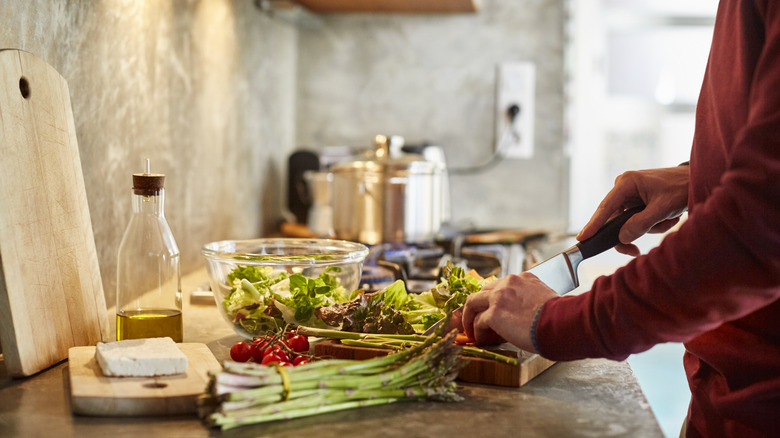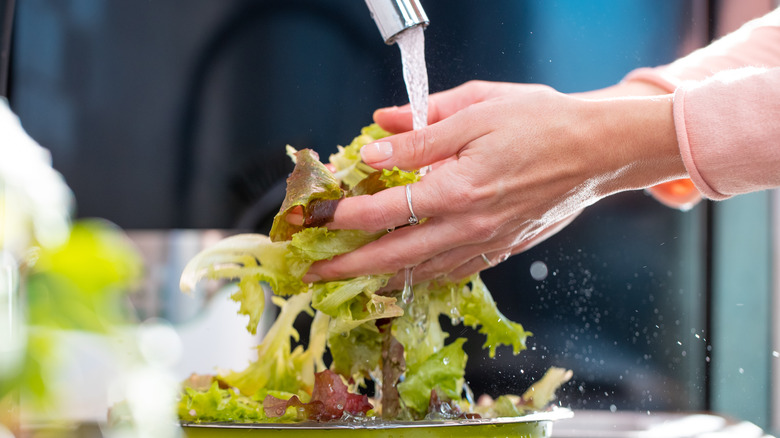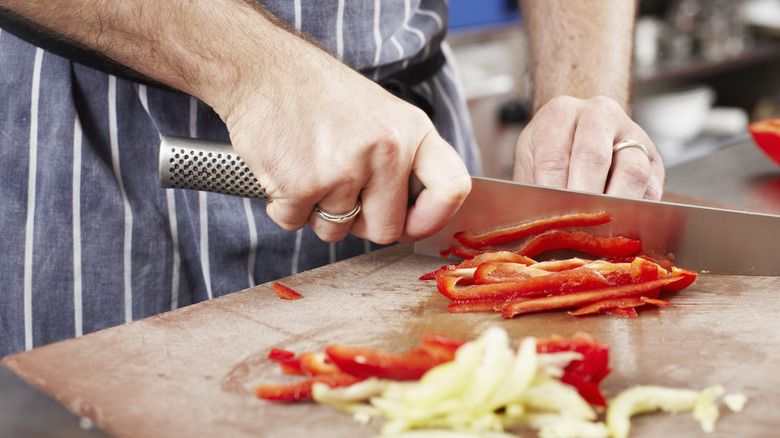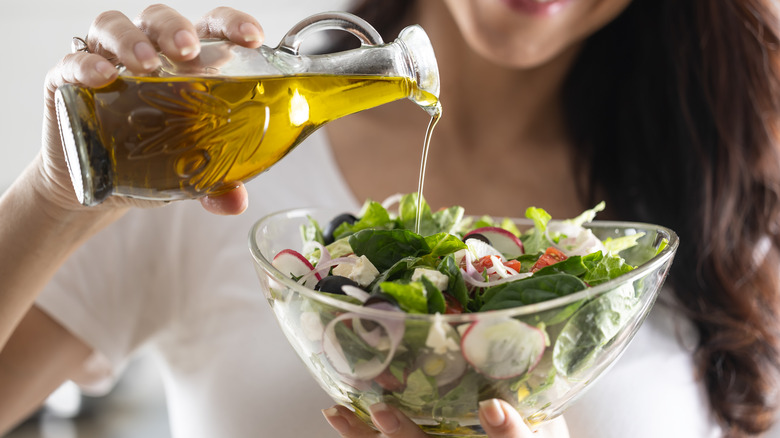3 Tips For The Quickest Salad Prep Ever
Salads are one of those commonplace dishes that nonetheless remain underappreciated. Not only do they come in an extensive array of forms, but they're well predisposed for a convenient meal. It's no surprise they've become the business lunch go-to; no heating is required, they're nutritious, and texturally interesting. So, to aid salad construction in a pinch, consider some prep tips to ease the process.
Pre-wash your lettuce, cut the greens (there's a handy hack for this), and chop up a range of delicious toppings. Take note of your vegetable durability, saving kale for later into the week, and eating spring mix first. Craft a delicious dressing that'll bind all your components with ease — truly leaving no cooking for when you're ready to eat.
After all, with a careful eye on the shelf life, salads are a surprisingly durable and easy-to-prep meal. Once you're ready to eat, all that'll be required is a quick mix — not to mention, serving the dish chilled is a great way to level up your salad game. So dive into some handy prep techniques not only for convenience, but for flavor enhancement, too.
Wash and slice leafy greens beforehand
Let's be honest: washing and drying large leafy greens is cumbersome. Whether you're one to use the sink or a large bowl, soaking lettuce requires some exertion to get rid of all the grit. Then, there's the trouble of drying, with laid out paper towels and a large surface area of greens to deal with. A salad spinner does help expedite the process, and there's an easy alternate method, too, yet it's still hugely convenient to knock out this stage beforehand.
So, whether you're dealing with arugula, butter lettuce, or a head of romaine, wash it all in one go, preferably right after purchase. Toss out any wilted leaves and dry the lettuce extra thoroughly — any water will worsen the stability. If you're dealing with a large lettuce head, you can even pre-slice the greens beforehand. Simple cut off the root, then slice across into approximately 1 to 2 inch strips. To save even more time, stack and slice your lettuce leaves in one go. This is especially time-saving when dealing with a leafy green like kale, in which you need to cut out the stem.
Regardless of the variety, line your container with paper towels, and place the lettuce into the crisper drawer. In such a format, it'll be good to use for two to three days. Just make sure to avoid adding any salt, seasoning, and vinaigrette. Waiting until you're ready to eat will enhance the texture twofold: It prevents further sogginess and lends a palatable salty crunch.
Prep sturdier ingredients for quick integration
A tasty salad isn't only about the leafy green base; it comes alive with textural additions. To craft the tastiest rendition, reach for sturdy ingredients that will give a good crunch. Start with bell peppers; this vibrant veggie does well in pre-sliced form. Cut into slivers and stored wrapped in paper towels in an airtight bag and they'll last for a week. Similarly, you can also julienne carrots and store the sticks in cold water for similar effect. Do the same with sliced celery, too, or wrap this stalky vegetable in foil.
Next, consider other additions that won't entail perishable considerations. Nuts are a great example: Toast walnuts, pine nuts, or de-shell pistachios, and store them in an airtight container for a week's time. In a similar vein, you can also allot a portion of dried fruit for later use — it'll add a perfect sweet finish to many ingredient combinations. And even crack open a package of olives, chopping up a few for a salty flourish.
And finally, consider some more satiating ingredients that will turn your salad into a full meal. Throw chicken thighs in the oven and pre-boil eggs for more protein; such components will store well in the fridge. Select a few nice cheeses — ranging from goat cheese to shredded parmesan — and you'll be poised to whip up a tasty salad in no time.
Craft tasty dressings in advance
Of course, you'll need a vinaigrette to tie your salad all together. Especially if you're after convenience, there's nothing wrong with purchasing the flavorful sauce pre-made. However, to really tailor the flavors of your homemade salad, craft the dressing at home. This way, you can control sugar, salt, and acidity, and even adjust for optimal freshness. Just make sure to avoid the ratio mistake that's killing your homemade salad dressing: Stick to three times as much oil as vinegar.
If you're prepping for up to a week's time, stick to exclusively shelf stable ingredients like oil, vinegar, honey, and mustard. Throw in citrus, garlic, herbs or any other vegetables, and the shelf life decreases to only about three days. Regardless of what ingredients are in your dressing, you'll want to keep the bottle in the fridge for both the freshest flavor and bacterial protection. It's best to employ a glass container; it wont take on any smells, and be much easier to wash afterwards, too. There are dedicated contraptions for the job, although a mason jar will work great in a pinch.
Remember that nearly all dressings are emulsifications, meaning the oil-based mixture isn't very stable. As a result, you'll need to give your dressing a shake to agitate the components right before serving. And if there's any solidification going on, let the sauce warm up to room temperature, and then stir and mix up your delectable salad.



